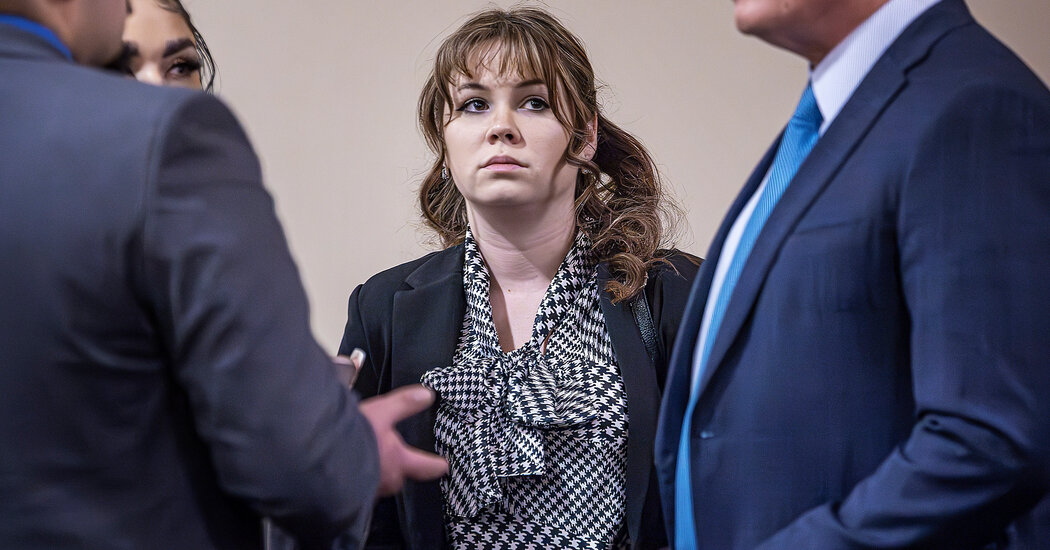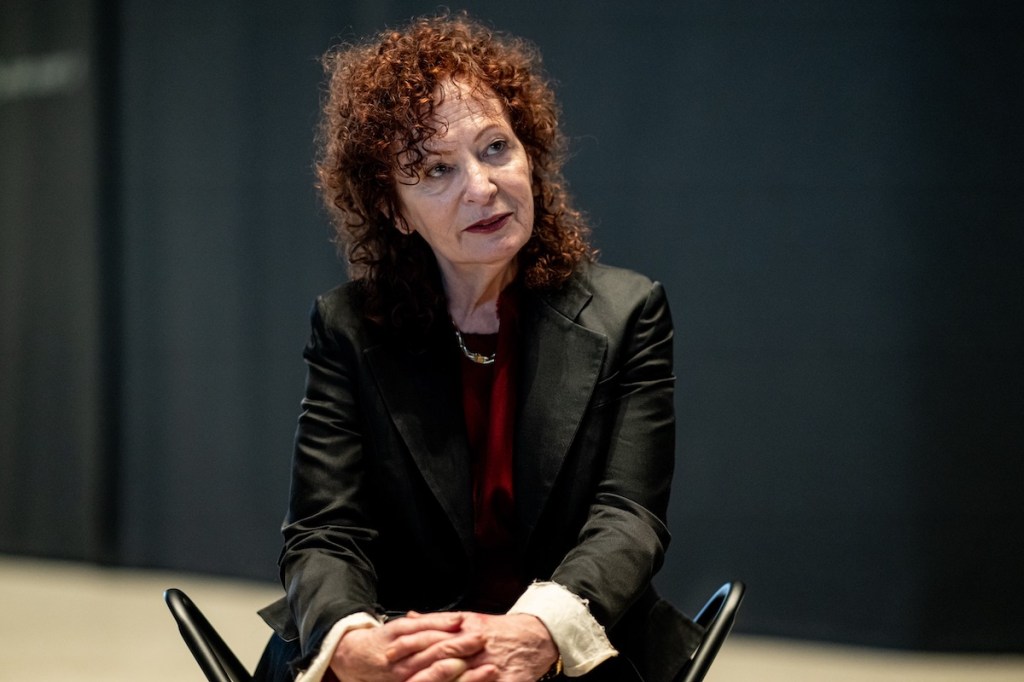The armorer who put a live round into the gun that Alec Baldwin was rehearsing with on the set of the film “Rust” when it went off, killing the cinematographer, was found guilty of involuntary manslaughter on Wednesday.
The conviction of the armorer, Hannah Gutierrez-Reed, marks the first time a jury has weighed in at trial on the fatal shooting of the cinematographer, Halyna Hutchins.
After the verdict was read, prosecutors asked that Ms. Gutierrez-Reed be taken into custody and the judge, Mary L. Marlowe Sommer, agreed. A court officer led Ms. Gutierrez-Reed out of the courtroom, not in handcuffs.
She faces up to 18 months in prison.
Mr. Baldwin is also facing a charge of involuntary manslaughter and is scheduled to stand trial in July. He has argued that he was not responsible, since he was told that there were no live rounds in the gun and there were not supposed to be any on the set.
Ms. Gutierrez-Reed’s trial, which lasted two weeks at the First Judicial District Courthouse in Santa Fe, N.M., focused on the fact that Ms. Gutierrez-Reed was supposed to load Mr. Baldwin’s revolver with dummy rounds, inert cartridges that are meant to resemble real bullets on camera but which cannot be fired.
But one round turned out to be live. When the gun went off on Oct. 21, 2021, as Mr. Baldwin worked with Ms. Hutchins to set up camera angles in a wooden church, it fired a bullet that killed her, wounded the film’s director and left the movie industry wondering how it could have happened on a set where live ammunition was supposed to be banned.
The prosecutors argued that Ms. Gutierrez-Reed had exhibited a pattern of negligence on the “Rust” set, calling crew members to the stand who criticized her conduct. They testified that she had left her prop cart, where she kept weapons and ammunition, in disarray and had sometimes failed to take weapons away from actors immediately after a scene finished filming.
The 12-person jury delivered its verdict after two and a half hours of deliberations. Outside the courtroom, one juror, Alberto Sanchez, said the jury had easily reached its decision by determining that Ms. Gutierrez-Reed had failed to properly carry out gun safety checks.
“That was her job to check those rounds and those firearms,” he said.
The trial had been animated by rounds of ammunition in plastic bags, photos of hundreds of more rounds and detailed demonstrations of how to operate the gun at the center of the shooting, a Pietta replica of an 1873 revolver.
Prosecutors accused Ms. Gutierrez-Reed of bringing the live rounds on set, showing the jury a photograph of her with what they said were the live rounds early in the filming, before a key shipment from the film’s main ammunition supplier.
Ms. Gutierrez-Reed has denied being the source of the live ammunition, and her legal team has defended her as being a young armorer whose authority was undercut by producers who sought to minimize costs, rushing the crew and overburdening Ms. Gutierrez-Reed with extra prop duties.
After the shooting, the police found six live rounds on the set, including the one that had been fired.
“This was a game of Russian roulette every time an actor had a gun with dummies,” Kari T. Morrissey, the lead prosecutor, said during closing arguments on Wednesday.
The jury found Ms. Gutierrez-Reed not guilty of a charge of evidence tampering related to an account from another “Rust” crew member that after the shooting, Ms. Gutierrez-Reed passed her a baggie of cocaine and asked if the crew member could hold on to it for her. The defense had argued that because the crew member threw out the baggie immediately, her testimony on the contents was not reliable.
In order to find Ms. Gutierrez-Reed guilty of involuntary manslaughter, the jury had to agree unanimously that she should have known of the danger involved in her actions that day and that she acted with a “willful disregard for the safety of others.”
Prosecutors sought to convince jurors that Ms. Gutierrez-Reed’s conduct had shown a pattern of negligence.
They showed jurors behind-the-scenes footage from the set that showed a stunt man holding a rifle in ways that the prosecution’s expert witness deemed unsafe, including pointing it toward a young actor and the back of the movie’s director, Joel Souza, without Ms. Gutierrez-Reed taking any action to intervene. (Mr. Souza was later wounded by the bullet that passed through Ms. Hutchins.)
“Ms. Gutierrez was unwilling to maintain proper firearm safety,” Ms. Morrissey said in court.
Because Ms. Gutierrez-Reed chose not to take the stand, the jury heard her perspective through her lawyers and through the footage of video interviews conducted with investigators from the sheriff’s office. Ms. Gutierrez-Reed told investigators that on the day of the shooting, she had loaded six rounds into the old-fashioned revolver Mr. Baldwin was using and that she had checked them all for signs that they were inert. But she acknowledged, “I wish I would have checked it more.”
Ms. Gutierrez-Reed told investigators that she showed the gun to Dave Halls, the movie’s first assistant director, spinning the cylinder so he could see the rounds inside.
Mr. Halls, who avoided prison time by taking a plea deal in the case, testified that although he and Ms. Gutierrez-Reed had regularly performed thorough safety checks of the guns used on set, they fell short that day. He recalled seeing only three or four rounds that were clearly inert out of the six loaded in the gun.
“I don’t recall her fully rotating the cylinder,” Mr. Halls testified, later acknowledging, “I did let that safety check pass.”
The defense argued that Ms. Gutierrez-Reed could not be held criminally responsible because she did not realize there were live rounds on set that day, and she could not have predicted that Mr. Baldwin would have pointed a gun at a crew member. They also repeatedly raised questions about the investigation by the sheriff’s office, asking why it had waited more than a month to search the office of Seth Kenney, the film’s primary weapons and ammunition supplier. Mr. Kenney testified that the live rounds did not come from him.
The defense’s key witness was an inspector from the state’s Occupational Health & Safety Bureau, who testified that the “Rust” production did not afford Ms. Gutierrez-Reed enough time to “conduct her duties to the best of her diligence.”
Outside the courtroom after the verdict, a lead lawyer for Ms. Gutierrez-Reed, Jason Bowles, said the defense planned to appeal. “We’re disappointed in a lot of things that happened in that courtroom,” he said, declining to elaborate.
In closing arguments, Mr. Bowles asserted that Ms. Gutierrez-Reed was a “convenient fall person” for the production’s mistakes, highlighting her low position on the chain of command. But Ms. Morrissey urged jurors not to concern themselves too much with the armorer’s age, arguing that when it came to guns, she was the boss.
“She is the autonomous decision maker with regard to gun safety,” she said.










